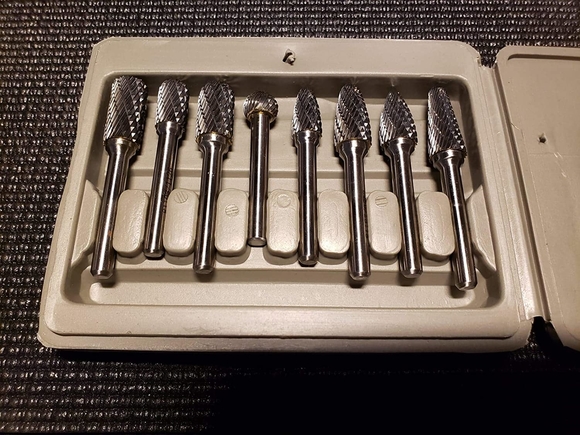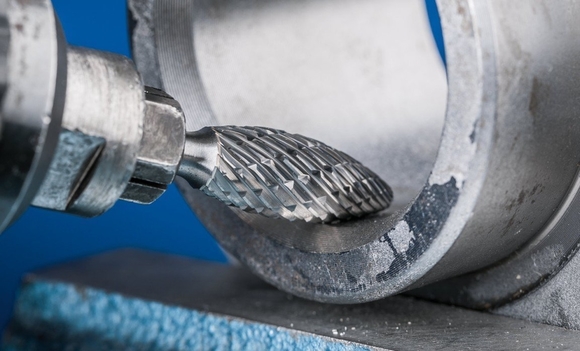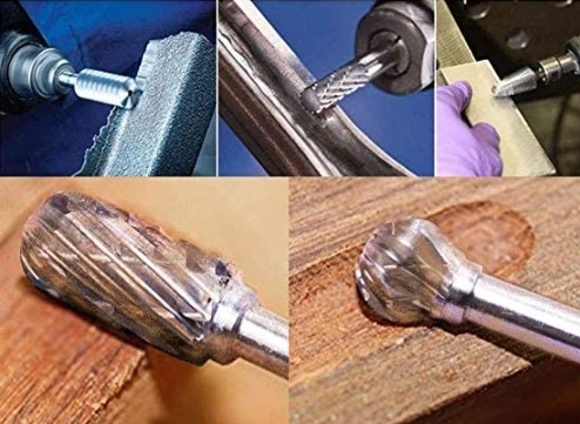Need a small, inexpensive tool for the daily grind? Look no further than carbide burrs. These small tool bits can cut, grind, shape, smooth out and remove excess materials in just about anything you can think of. That’s why they’re used by a wide range of professionals in as many applications, from metal workers and welders, to carpenters and jewellers. If they’re still unfamiliar, then, you’ve certainly seen them at the dentist. They’re the bits in dental drills that send the most shivers in anyone getting tooth fillings.
What are Carbide Burrs?
Carbide burrs, or rotary burrs/rotary files, are rotating tools used in removing materials. They’re particularly good in removing burrs, sharp edges and uneven surfaces as well as cutting, shaping and grinding into materials where ordinary drill bits just don’t make the cut. Carbide burrs are mainly used with a die grinder, that spins the bits at high speeds. There are different shapes in which they come in, and these determine the shape of the cut.

What are Carbide Burrs Made From?
As opposed to HSS steel, carbide burrs are made from a combination of carbon and metal. For most uses, this is Tungsten, a very hard metal, that is also one of the toughest there is. The alloy (tungsten carbide) is just short of a diamond in overall toughness, so will make easy work in any material. The bits won’t run as hot as HSS steel, are harder, and will last longer. The ideal bit to have in demanding jobs.
What can Carbide Burrs be Used on?
With high toughness, carbide burrs can be used in many different materials. This includes workpieces made from ferrous metals, like cast iron or various steel alloys, as well as non-ferrous metals, particularly aluminium and aluminium alloys. Other common metals, like copper, zinc, nickel, cobalt and titanium and alloys like brass and bronze can also be worked on. Softer precious metals including gold and silver are often shaped by jewellers. But it’s not just metals where carbide burrs find regular use. Plastics, carbon fibre, ceramics, stone and any combination of different materials can be shaped easily and quickly with a carbide burr.

Where are Carbide Burrs Used?
The wide range of materials listed above makes carbide burrs extremely versatile. They’re used by metal workers, toolmakers, panel beaters, welders, mechanics, carpenters, woodworkers, sculptors, dentists, artists, jewellers and in many more professions. Of course, they are in different shapes, and sized to the task at hand. But the general idea is that this is what you want when you need a quick and smooth finish to your project.
Which Tools are Carbide Burrs Used With?
The main tool is a die grinder. These can be pneumatically driven to reach higher RPMs when facing really tough materials. Or smaller cordless die grinders that are adequate for light to medium-duty jobs, with the added bonus of mobility. Other rotary tools, like dentistry or jeweller drills, fit smaller carbide burr bits. To avoid any injuries, and the sheer amount of deburred material getting in the eyes or breathed in, always use the appropriate PPE gear with rotary tools and carbide burrs.

What to Look for When buying?
Types of Carbide Burrs
Based on the design of the cutting profile, carbide burrs come in two basic types – single cut and double-cut. Single cut burrs have one cutting edge arranged along the whole length of the bit and spiralling its way from top to bottom. The grooves are wider and ideal for cutting into harder ferrous metals, like stainless steel or cast iron. They are also meant to remove larger portions of metal at a time, so work quickly but leave an uneven surface. This is where the double-cut carbide burr comes in. They smooth out any excess materials in rougher surfaces dues to the cross-cut arrangement of the flutes. These are spaced out at smaller distances. Double-cut burrs are ideal for delicate finishing jobs that require smoother finishes in metals, plastics, wood or ceramics. Professionals will have a combination of both types, starting out a job with a single-cut carbide burr, and detailing the workpiece with a double-cut carbide burr.
Shapes and Sizes
This is where there is a lot of variety. Different shapes allow for different types of cuts. Ball-shaped burrs are good for getting hollowed out concave shapes; tree burrs will do the same but with tighter angles; and cylindrical carbide burrs are good for getting a flat surface at right angles. Cone-shaped burrs, either ordinary or inverted, can be used for finishing jobs in tighter edges and corners. There are also flame and oval-shaped burrs. The differences in shape may be slight, but the resulting cuts differ as do the places where they can be used. In addition, all rotary files can have pointed or tapered edges.
Size refers to the overall diameter of the burrs. Common sizes are ¼, ½ and 1 inch, with a wide range in between. There are also variants with longer shanks, or the parts that fit into the die grinder. These allow you to get in deeper, so are used for tighter spaces. A good idea is to go for a carbide burr set, that includes differently shaped burrs, or the same shape, but in different sizes.


















